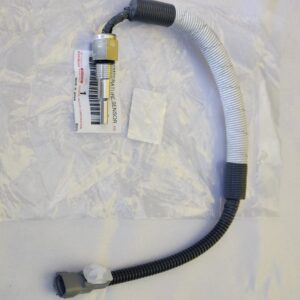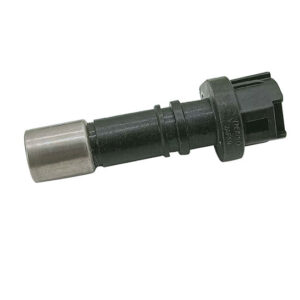Title: The Precision Pulse: Exploring the Role of the Crankshaft Sensor in Automotive Engines
In the intricate symphony of an automotive engine, precision is paramount. Every revolution, every combustion event must be meticulously orchestrated to ensure optimal performance and efficiency. At the heart of this symphony lies the crankshaft sensor—a small yet powerful device that plays a pivotal role in synchronizing engine operation. In this blog, we’ll delve into the significance of the crankshaft sensor, how it works, its types, and its indispensable contribution to the smooth and efficient operation of automotive engines.
### Understanding the Crankshaft Sensor
The crankshaft sensor, also known as the crankshaft position sensor (CKP sensor), is a vital component of the engine management system. It is typically located near the crankshaft or flywheel and is responsible for monitoring the rotational speed and position of the crankshaft.
### How the Crankshaft Sensor Works
The crankshaft sensor operates using various technologies, including Hall effect, magnetic reluctance, or optical sensors. Regardless of the technology used, the basic principle remains the same: the sensor detects the passage of teeth or markers on the crankshaft or flywheel as it rotates, generating electrical signals that are interpreted by the engine control unit (ECU) or powertrain control module (PCM).
### Types of Crankshaft Sensors
1. **Hall Effect Sensors**: Hall effect sensors utilize a semiconductor device to detect changes in magnetic fields caused by the rotation of teeth or markers on the crankshaft or flywheel. These sensors are reliable and commonly used in modern automotive engines.
2. **Magnetic Reluctance Sensors**: Magnetic reluctance sensors rely on changes in magnetic flux density as teeth or markers on the crankshaft or flywheel pass by the sensor. These sensors are less common but are still found in some older vehicles.
3. **Optical Sensors**: Optical sensors use a light source and detector to detect interruptions in the light path caused by the rotation of teeth or markers on the crankshaft or flywheel. These sensors are highly accurate but may be more susceptible to contamination or damage.
### Importance of Crankshaft Sensors in Engine Operation
1. **Timing Control**: Crankshaft sensors provide essential data to the ECU or PCM, allowing precise control of ignition timing, fuel injection timing, and valve timing. This ensures optimal combustion efficiency and engine performance.
2. **Misfire Detection**: Crankshaft sensors can also detect engine misfires by monitoring variations in crankshaft speed and position. This information allows the ECU or PCM to identify and correct misfire events, reducing emissions and improving engine reliability.
3. **Stability and Smoothness**: By continuously monitoring crankshaft speed and position, crankshaft sensors help maintain stable engine operation and smooth acceleration, even under varying driving conditions.
### Conclusion
In the complex world of automotive engineering, the crankshaft sensor emerges as a silent sentinel, monitoring the heartbeat of the engine with precision and accuracy. From timing control to misfire detection and overall stability, the role of the crankshaft sensor in shaping engine performance and efficiency cannot be overstated. As automotive technology continues to advance, the importance of crankshaft sensors in achieving optimal engine operation remains undeniably critical, ensuring that every revolution of the engine is a symphony of precision and power.
In stock (can be backordered)
$29,137.67
Title: The Precision Pulse: Exploring the Role of the Crankshaft Sensor in Automotive Engines
In the intricate symphony of an automotive engine, precision is paramount. Every revolution, every combustion event must be meticulously orchestrated to ensure optimal performance and efficiency. At the heart of this symphony lies the crankshaft sensor—a small yet powerful device that plays a pivotal role in synchronizing engine operation. In this blog, we’ll delve into the significance of the crankshaft sensor, how it works, its types, and its indispensable contribution to the smooth and efficient operation of automotive engines.
### Understanding the Crankshaft Sensor
The crankshaft sensor, also known as the crankshaft position sensor (CKP sensor), is a vital component of the engine management system. It is typically located near the crankshaft or flywheel and is responsible for monitoring the rotational speed and position of the crankshaft.
### How the Crankshaft Sensor Works
The crankshaft sensor operates using various technologies, including Hall effect, magnetic reluctance, or optical sensors. Regardless of the technology used, the basic principle remains the same: the sensor detects the passage of teeth or markers on the crankshaft or flywheel as it rotates, generating electrical signals that are interpreted by the engine control unit (ECU) or powertrain control module (PCM).
### Types of Crankshaft Sensors
1. **Hall Effect Sensors**: Hall effect sensors utilize a semiconductor device to detect changes in magnetic fields caused by the rotation of teeth or markers on the crankshaft or flywheel. These sensors are reliable and commonly used in modern automotive engines.
2. **Magnetic Reluctance Sensors**: Magnetic reluctance sensors rely on changes in magnetic flux density as teeth or markers on the crankshaft or flywheel pass by the sensor. These sensors are less common but are still found in some older vehicles.
3. **Optical Sensors**: Optical sensors use a light source and detector to detect interruptions in the light path caused by the rotation of teeth or markers on the crankshaft or flywheel. These sensors are highly accurate but may be more susceptible to contamination or damage.
### Importance of Crankshaft Sensors in Engine Operation
1. **Timing Control**: Crankshaft sensors provide essential data to the ECU or PCM, allowing precise control of ignition timing, fuel injection timing, and valve timing. This ensures optimal combustion efficiency and engine performance.
2. **Misfire Detection**: Crankshaft sensors can also detect engine misfires by monitoring variations in crankshaft speed and position. This information allows the ECU or PCM to identify and correct misfire events, reducing emissions and improving engine reliability.
3. **Stability and Smoothness**: By continuously monitoring crankshaft speed and position, crankshaft sensors help maintain stable engine operation and smooth acceleration, even under varying driving conditions.
### Conclusion
In the complex world of automotive engineering, the crankshaft sensor emerges as a silent sentinel, monitoring the heartbeat of the engine with precision and accuracy. From timing control to misfire detection and overall stability, the role of the crankshaft sensor in shaping engine performance and efficiency cannot be overstated. As automotive technology continues to advance, the importance of crankshaft sensors in achieving optimal engine operation remains undeniably critical, ensuring that every revolution of the engine is a symphony of precision and power.
| Warehouse | Inventory at warehouse 2 |
|---|


Get E-mail updates about our latest products and special offers.
Sensors and More is Jamaica’s ultimate online auto parts store. Established in 2020, we specialize in genuine electrical parts for Japanese, Read more…
Reviews
There are no reviews yet.